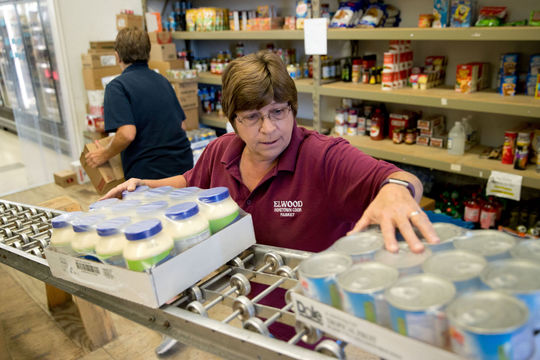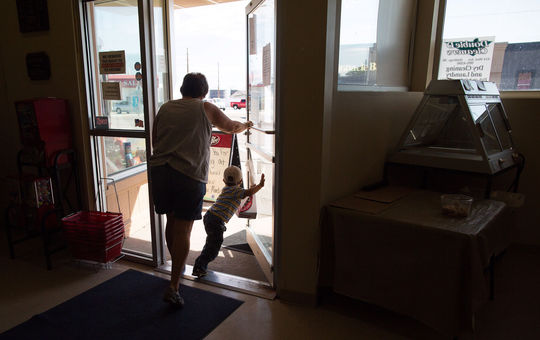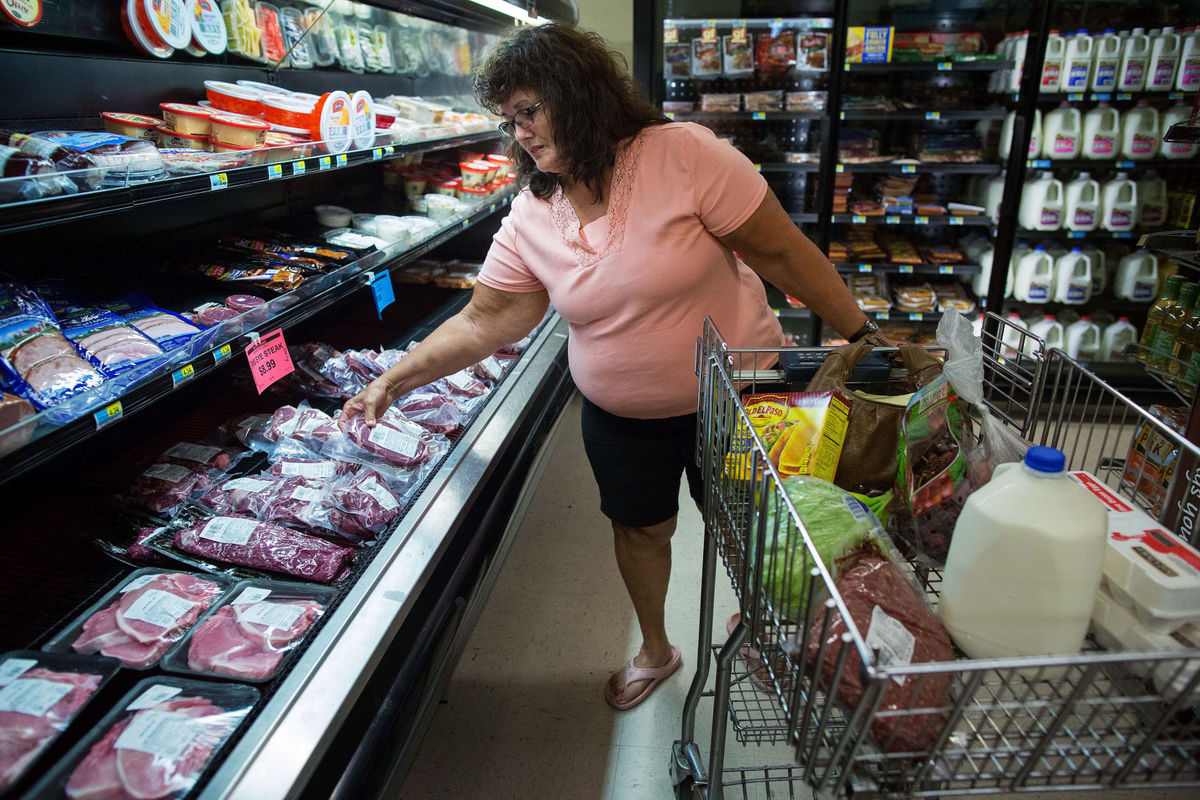Omaha World-Herald: Nebraska small-town citizens put money where their mouths are to keep rural grocery stores open
By Barbara Soderlin | Sep 24, 2017
ELWOOD, Neb. — The sun rises over the bank branch on the other side of Smith Avenue and shines on the Elwood Hometown Cooperative Market, where pots of red geraniums greet customers and a woman sweeps sidewalk debris into a tidy pile.
It’s 8 a.m. on a Thursday, time to open the store, and a good day to shop — the day the delivery truck comes with fresh milk, apples, meat and other groceries for this town of 700.
It’s a lively scene that might not have been. The store, in operation for decades, shuttered in 2012. That’s a regular problem in small towns across Nebraska as farms consolidate and rural populations decline.
When a small-town grocery store closes, it’s about more than just food. The store is a linchpin: a place to run into neighbors or apply for a job. It helps attract new families, and donates to local sports teams and other community efforts.
Elwood, about a 3½-hour drive southwest of Omaha, didn’t want to let that go. Amid a larger community revitalization effort that included a new library and a spruced-up downtown, residents reopened the market in 2013 under co-operative ownership, with more than 140 people buying one or more $500 shares in the business, and putting management in the hands of a board of directors.
It’s happening across Nebraska. Other towns, including Cody, Arthur, Odell, Stapleton, Scottsbluff and Kimball, have opened or maintained grocery stores under some form of collective ownership.
The Elwood co-op’s total investment of $307,000 included buying and remodeling the building, purchasing equipment and stocking the store with inventory. Stores that are run as co-ops are for-profit businesses, but owners don’t always expect a big dividend, said Jim Crandall, a cooperative business development specialist at the University of Nebraska-Lincoln who advises communities, including Elwood, on how to form co-ops.
“If you want to invest for your retirement, go buy Buffett,” he said. “If you want to invest in your community so it has the things you need to be able to live here, invest in the store.”
Four years in, Elwood’s store is still a success story, although it has yet to be able to pay a dividend. On delivery day, manager Julie Poggendorf, one of several paid employees, unloads, sorts and stacks heavy boxes in the back, working so fast that sweat soon soaks her hair. In the kitchen, cook Betsy Gruebele boils water in preparation for the daily lunch special: creamy turkey and noodles over biscuits.
Up at the front of the market, shopper Loren Vancura, a retired Farm Service Agency director, puts a loaf of bread and packs of cheese and deli meat on the conveyor belt at the store’s single cash register. He does 80 percent of his grocery shopping here.
Without the store, he said, “you’d have to go to Lexington.”

Store manager Julie Poggendorf helps unload a supply truck at the Elwood Hometown Cooperative Market.
Smith Avenue, the main drag in Elwood, takes traffic past Our Redeemer Lutheran Church, the Gosper County Courthouse and the Elwood Care Center, then the 17 miles north to Lexington, a city of 10,000, where the Walmart Supercenter is the Elwood Market’s main competition.
But though Elwood and several newer co-op stores report success so far, that doesn’t mean every small town will be able to pull it off, or that the longevity of even a well-run co-op store is guaranteed.
Co-ops can face some of the same struggles that independently owned grocery stores do: narrow profit margins, and a hard time maintaining community support. Rural Nebraskans are mobile. They commute long distances to bigger cities, where it’s easy to shop for groceries after work.
Many are not especially loyal to their hometown grocery store, either.
Fewer than a third of rural Nebraskans are like Vancura, buying most of their food at a small local grocery store. About a third typically shop in a supermarket, and more than a third buy most of their food from a supercenter, typically Walmart.
That’s according to results of the latest Nebraska Rural Poll, published in August by the University of Nebraska-Lincoln. Nearly 2,000 rural Nebraskans answered questions about their grocery shopping habits.
Many who shop at a Walmart do so despite having a local store closer to their home, the survey found. People who work in agriculture or have less education or lower incomes are more likely to say they shop at small local stores, according to the survey.
Community store operators dispute their customers’ claims that Walmart is cheaper on some items, especially considering the cost of travel. They say they depend on continued local support if they’re to remain open.
But rural Nebraskans say it’s not just about price: quality, cleanliness and selection round out their top four reasons for choosing a store. Quality and selection especially can be difficult areas for small stores to compete.
“We have a little bit of fresh produce and meat, but not a whole lot of fresh produce,” said Cathy Bures, manager of the Odell Market in the Gage County town of 300, a little more than an hour’s drive south of Lincoln.
The Elwood store offers more in the way of selection than some other rural stores can. Unlike the Odell store, it’s big enough to qualify for a weekly delivery from distributor Associated Wholesale Grocers. Very small stores sometimes have to buy their groceries from another grocery store, split a delivery with another store, or take delivery less often.
Shoppers at the Elwood Market also have an advocate in Sharlette Schwenninger, an Elwood native who moved away but returned later in life. Schwenninger, chairwoman of the co-op board of directors, loves to cook and is proud the store carries ingredients such as balsamic vinegar, gluten-free bread, sea salt and extra virgin olive oil, alongside not-so-gourmet canned vegetables, Hot Pockets and Cheez Whiz.
“We even have capers,” she said.
The colorful produce section carries grapes, cantaloupe, cherries, peaches, plums, blueberries and whole pineapple. The Elwood store doesn’t sell alcohol or tobacco, but it has a well-stocked pharmacy section, so there’s no need to go to Lexington for razors, Q-tips, dental floss or a pregnancy test. When she was a girl, Schwenninger said, the store owners wrapped boxes of sanitary napkins in brown paper, for modesty’s sake. Today’s market has tampons on full display.But it struggles with some items. The store ran out of milk one recent week before its regular Thursday delivery arrived. You just never know what people will buy from week to week, said Poggendorf, the manager.
At the Circle C Market in Cody, a Sand Hills town of 150 people about a six-hour drive northwest of Omaha, milk sales fluctuate if a single family with several kids goes on vacation that week, manager Janet Shelbourn said. “It literally makes a difference: Do we get six cases of milk this week, or do we get five?”
The fear of losing its local grocery sent Elwood into overdrive when the market closed in January 2012. Community leaders conducted surveys and formed a steering committee, with subcommittees dedicated to the finances, the building, marketing and incorporation.
The group studied various business models, and the co-op model emerged the clear choice, Schwenninger said.
“The more people who have a financial interest in it, the more people are likely to shop and support it,” she said.
The committee worked its way through some disagreements — like the one about whether to keep the decorative pressed-tin ceiling, or install an energy-efficient, lower-hanging drop ceiling.
“The guys on the building committee wanted to do a drop ceiling, and the ladies on the committee, we fought really hard,” Schwenninger said. The women prevailed.
A study showed that the Elwood area had about $1.8 million in annual grocery sales, and the committee figured the store could be successful if it could capture a third of that, about $600,000 a year — which it has, Schwenninger said. (By comparison, the average Hy-Vee supermarket does about $38 million in sales a year.)
You don’t have to be a shareholder or a member to shop at the store. People who spring for a $25 membership get special deals, such as a discount on steaks.
Schwenninger said she buys nearly all her groceries at the store, and finds it frustrating that there are still some people in town who never shop there.
Her pitch: Shopping locally keeps more money in town, both the store revenue and the tax dollars. While most grocery store food isn’t taxed, the Elwood store also sells household goods that are taxed, and pays property, payroll and business taxes.
“It’s an investment in the community. It’s helping to ensure that this store will be here for you and your children.”

Jodi Klassen and her grandson Coltin Nation, 3, leave the Elwood Hometown Cooperative Market after buying Coltin a treat.
RYAN SODERLIN/THE WORLD-HERALD
The closing of a rural store is not like in Omaha, where grocery retailers are falling over each other to compete for shoppers’ dollars. Some residents of Omaha have four or five supermarkets battling it out within a mile of their homes, plus the ability to order groceries delivered to their doorsteps the same day.
In a rural area, the other option might be a convenience store or, increasingly, the dollar stores moving into rural areas. Dollar General, the Tennessee-based chain with more than 14,000 locations, now operates more than 110 stores in Nebraska, including in towns with populations of fewer than 1,000.
Dollar General sells shelf-stable food, snacks and pop, but typically does not sell any fresh produce, much fresh meat, or a wide variety of other grocery items.
Big swaths of rural Nebraska qualify as “food deserts,” a term the U.S. Department of Agriculture uses to describe places with low access to sources of healthful food, and where low incomes or poor access to transportation makes it hard for people to get to a store.
It might seem strange to think of productive farm country as a food desert, but Nebraska’s millions of acres of corn and soybeans don’t directly put food on local tables — they’re the raw ingredients for processed food and for animal feed.
Food deserts contribute to diet-related health problems and are especially problematic for seniors and the poor, said Kathie Starkweather, director of farm and community programs at the Center for Rural Affairs in Lyons, Nebraska.
Meanwhile, she said, the people who buy groceries out of town tend to spend even more of their money while they’re away, at medical offices and other retailers. That creates a domino effect: “All that wealth is leaving the community.”
Towns that want to save their store have help. Crandall at UNL travels the state offering advice on how to form a co-op business. The Center for Rural Affairs has information about grants and is working with other organizations on policy changes that could improve food access.
And at Kansas State University, the Rural Grocery Initiative can connect store owners with assistance on cutting energy costs and marketing analysis. David Procter, director of the university’s Center for Engagement and Community Development, said it’s getting tougher all the time for rural stores to make it.
Some communities in Kansas are even putting taxpayer dollars behind keeping stores open, seeing access to food as a critical infrastructure need, like electricity, roads or Internet access.
“If a grocery store closes,” he said, “it’s really a serious blow to a town.”

